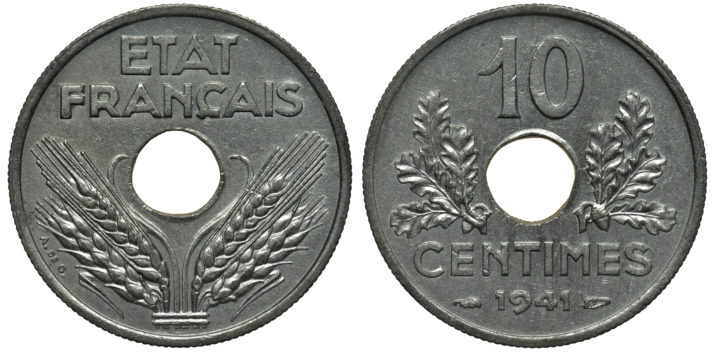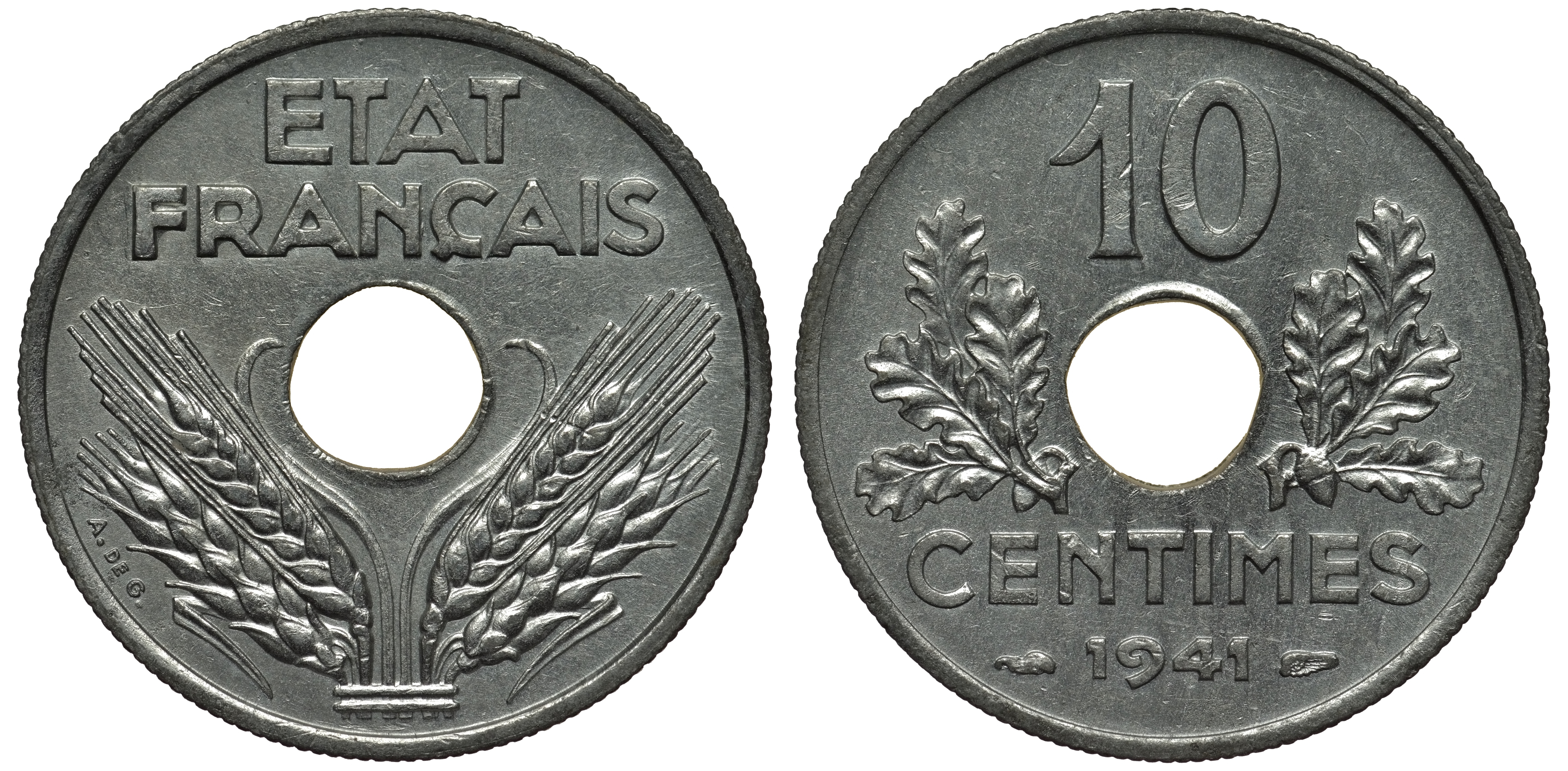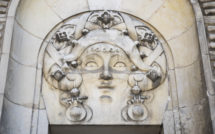

This is part of a roundtable, Author-Meets-Critics: Vichy contre Vichy, Une capitale sans mémoire by Audrey Mallet
Audrey Mallet’s Vichy contre Vichy: Une capitale sans mémoire is a welcome addition to scholarship on French experiences of World War II and their legacy in memory and commemoration. In this engaging book, Mallet examines the factors that shaped the wartime experiences of the town of Vichy (which was the provisional capital of France and seat of Marshal Philippe Pétain’s collaborationist government from 1940 to 1944), the responses of the local population, and the ways in which these experiences and responses have been remembered locally (or not remembered) since the end of World War II. Although Mallet ultimately concludes that the town of Vichy is an anomaly in the French memorial landscape, her careful and nuanced case study is broadly illuminating. Mallet persuasively dispels some long-standing myths (such as the inaccessibility of Vichy’s archives, the financial burden the national government inflicted on the town, or the protection of Vichy’s Jewish population), and brings significant new insights to bear, in particular regarding the role of the Algerian war in shaping the politics of memory in Vichy, and the resurgence of a “subterranean,” nostalgic Pétainism among Vichyssois.
The book begins with an initial sketch of Vichy’s ascendency to the status of Queen of Spas in the Second Empire and Belle Époque. Chapter two then describes Vichy’s transition from “thermal capital” to national capital in the summer of 1940. The first effect of the war for Vichy, however—even before the dissolution of the Third Republic and the establishment of the État Français—was an influx of refugees (300,000 between September 1939 and June 1940) to whom Vichy’s mayor, Pierre-Victor Léger, pledged solidarity, but whose experiences in the town were mixed. Many French communities struggled with the chaos created by displaced populations. For Vichy, however, government functionaries soon took the place of refugees, the town’s population quintupled, and local concerns took a much different form from those in the rest of the country. The presence of the national government in Vichy created both opportunities and challenges. There is no question that the government brought income to the town.[1] Vichy’s augmented status also led to its promotion to sub-prefecture in 1941. The main disadvantage to the presence of the government in the heart of Vichy’s quartier thermal, however, was the suspension of tourism to the resort and the loss of Vichy’s spa clientele. The municipality tried various measures to keep the resort running, but without much success. Furthermore, the implantation of the government in Vichy brought with it a disproportionate presence of German forces, Gestapo, and Milice for the size of the town.
Faced with this distinctive wartime situation, the majority of Vichy’s population adopted a resolute attentisme, according to Mallet. The passivity of Vichy’s population was in part the result of a local culture invested in both catering to the needs of the resort’s guests and maintaining a discreet distance from their activities. Mallet also points out that day-to-day interactions with members of the government humanized the regime—many were the Vichyssois who cherished memories of Pétain, in particular. Furthermore, what resistance there was in Vichy tended to be of the “Vichyste” variety (those who supported Pétain’s National Revolution but opposed the German occupation), rather than communist or Gaullist. As a result, and despite fairly vigorous propaganda, pro-German collaborationist groups did not gain traction in Vichy either.
Like its “occupation,” Vichy’s liberation was distinctive. The Swiss ambassador, Walter Stucki, assumed leadership of the municipality, and supervised the German withdrawal and the peaceful handover of the town to the Forces françaises de l’intérieur (FFI). For saving Vichy from the twin threats of French and German vengeance, Stucki was made an honorary citizen of Vichy on August 29, 1944; he was the first person to have a street named for him after the war, and is honored every year on the anniversary of Vichy’s liberation.[2] The postwar purges in the region were marked by more high-profile cases, but less extra-judicial excess (and a notable absence of violence against women and children). Reconstruction was dominated by concerns over the return of Vichy’s affluent tourist clientele: efforts focused on the town’s elegant hotels and restaurants, spa infrastructure, and casinos.[3]
Given its distinctive experience of war and liberation, it is unsurprising that the postwar discourses that dominated elsewhere were not taken up in Vichy. There were some early attempts to entrench heroic narratives of resistance in Vichy (most notably the remarkable Nouveau Mémorial de Vichy, compiled by a group of resisters and published in 1946), but even these kept their distance from both Gaullist and communist rhetoric because neither meshed with Vichy’s realities.[4] Rather, memory in Vichy crystallized around themes of stoicism, victimhood, and endurance. A revealing example of the impact of this trend is found in the May 1945 election following Pierre-Victor Léger’s removal from office. The first candidate, Louis Moinard, had been Léger’s wartime deputy mayor. He was also an early member of the Organisation de résistance de l’armée (ORA), and had transported money, arms, and information to North Africa.[5] The other candidate was Jacques Guillaumin, a militant World War I veteran and trade unionist, and an active member of the communist resistance in the Allier. Guillaumin had been arrested and interned in October 1940, and then deported in 1941, only to return to Vichy in 1944.[6] In May 1945, then, the Vichyssois had a choice between two decorated resisters. Guillaumin—the communist deportee—represented a rupture with the wartime municipality. Moinard—the former deputy mayor—represented continuity and solidarity with Léger. Moinard swept the polls, completed a four-year term, and then stepped down in favor of Léger who handily took the elections in 1949, the first in which he was eligible to run. In Pierre-Victor Léger, the Vichyssois saw a reflection of themselves: he had lived all the ambiguities of life in the provisional capital and became a symbol of the town’s stoic endurance and unjust treatment.
One of the most significant points Mallet makes in this book is that, with the entrenchment of a narrative of victimhood in which the Vichyssois focus exclusively on their own fate, the history of the town’s Jewish victims is obscured. In chapter four, Être juif à Vichy, Mallet describes this surprisingly overlooked facet of the town’s wartime history. Vichy’s tradition of hospitality had made the town a haven for Jews in the late nineteenth and early twentieth centuries. In order to cater to wealthy Jewish spa clients, the town built a synagogue, and boasted several kosher butchers. The municipality spoke out emphatically against antisemitism, but with the arrival of the État Français, Vichy’s Jews became vulnerable. In two waves of expulsions in 1940 and 1941, most of the town’s Jewish population (whether refugees or permanent residents) was dispersed. Those who escaped the first expulsions were mostly deported in the roundups of 1942. And yet there persists in Vichy an impression that the town’s Jews were protected by Pétain or other government leaders. This was perhaps the case for Pétain’s pharmacist, for example, but the exception has been taken for the rule, reinforced by a general adherence to the (elsewhere) discredited idea that Pétain was the shield that would protect France. The Jewish population in Vichy today does not testify to the protection of the town’s Jews by the regime, rather Vichy’s Jews are now mostly of North African origin, having arrived in the 1960s equipped with a different set of wartime memories.
Indeed, the Algerian war and an influx of Pied-Noir settlers in the 1960s appears as a primary political determinant and vector of memory in Vichy. The town not only had long-standing links with France’s colonies, it was the “heart of the colonial matrix.”[7] Vichy’s colonial connections and sympathies engendered support for a French Algeria and, later, for Pied-Noir settlers who would make up ten percent of the town’s population from the 1960s. The loss of Vichy’s colonial clientele, the arrival of a large and politically important Pied-Noir community, and the presence in Vichy of organizations and individuals dedicated to the preservation of French Algeria, such as the Front Algérie Française (FAF) and the Organisation armée secrète (OAS) had fundamentally important political consequences. Vichy drifted rightward, washed its hands of de Gaulle, took a second look at its World War II experiences, and found a rejuvenated and re-legitimized support for Pétain, defender of France and its Empire. Thus, when the rest of France entered an obsessional phase of “coming to terms with Vichy” in the 1980s and 1990s, Vichy itself was unmoved. There was nothing with which to come to terms, the town’s leaders declared, and nothing to apologize for. Rather it was France which ought to apologize, for saddling Vichy with this history and for sullying the town’s name.
Contrary to the book’s title, Mallet in fact stresses the extent to which Vichy was (and still is) at odds—not with its past—but with the rest of France. Vichy’s experiences of war, occupation, liberation, purges, and postwar reconstruction were largely, perhaps necessarily, different from those of the rest of the country. And although the town briefly attempted to insert itself into postwar narratives of resistance, these efforts were half-hearted and short-lived. Very quickly, this heroic narrative was superseded by a discourse of victimhood characterized by resentment towards de Gaulle, secret sympathy for Pétain, defiant resistance against any “duty to remember,” and bitterness towards a French nation that persists in using the town’s name to stand for the Dark Years as a whole. Indeed, outrage over the misuse of Vichy’s name is the only form that public, official memory of the war years takes in the town. Everything else is shrouded in defensive silence, giving rise—Mallet contends—to rumor, hearsay, voyeurism and an unhealthy curiosity among tourists and others determined to uncover what has been hidden or erased. Mallet, herself from Vichy, indeed reveals a number of hidden histories: the existence of a secret “Pétain room,” more shrine than exhibition, in the former municipal museum where Pétainist memorabilia was carefully collected and displayed, but which was closed to the public; links between the town of Vichy and the FAF and OAS; a political assassination by the Front de libération nationale (FLN) outside the Carleton hotel (and then the subsequent murder of the assassin). Despite a long tradition of official reticence, however, Mallet stresses recent shifts in attitude, notably an increasing willingness and interest among ordinary Vichyssois to discuss the war years. She herself is contributing to this process through a mobile app, Vichy 1939-1945, available in English and French, in which key sites related to the wartime history of Vichy are identified and discussed, accompanied by historic images and primary documents.
One of the strengths of Vichy contre Vichy is Mallet’s clear focus on the town (i.e.: the municipal government and population) of Vichy. But there are two other key actors in Vichy’s history—the Compagnie fermière de l’Établissement thermal de Vichy (CfV), and the Société des grands hôtels de Vichy (SGHV). These two organizations, not the municipality, owned and operated the resort in the heart of the town that housed the État Français. Unlike the municipal archives which are open to and welcoming of researchers and the public (and here I agree completely with Mallet that, in both the municipal archives and the médiathèque, the staff could not have been more helpful or engaged), the private archives of the Compagnie fermière and the SGHV are largely inaccessible. A lack of evidence limits our ability to assess their wartime situation, and Mallet is—perhaps wisely—circumspect: “les membres des deux groups auraient ainsi adapté leurs comportements et actions vis-à-vis du gouvernement et de la Résistance en fonction de leurs croyances personnelles, de leur niveau d’opportunisme (et d’hypocrisie), de leurs ressources et des circonstances du moment.”[8] She does identify these two organizations as being central to Vichy’s place in a “colonial matrix,” but I would argue that they are equally important to the “memory matrix” of the town. They long played a central role in shaping the kind of place Vichy was and the image it projected of itself, including contributing to its postwar silences and erasures. Likewise, the influence of L’Oréal and Perrier in the more recent economic life of Vichy is not without consequence for memory and politics. Indeed, Vichy’s relationship with these two companies has fed, even amplified, feelings of victimhood and nostalgia. These, however, are issues to be taken up by future projects. With Vichy contre Vichy, Audrey Mallet is to be commended for the light she shines on the dark years and their legacy in Vichy.
Kirrily Freeman is Associate Professor of History at Saint Mary’s University in Halifax, Canada. Her publications include Bronzes to Bullets: Vichy and the Destruction of French Public Statuary, 1941-1944 (Stanford University Press, 2009) and several articles on the town of Vichy and the politics of identity in the two World Wars and the interwar period.
Vichy contre Vichy: Une capitale sans mémoire
By Audrey Mallet
Publisher: Belin
e-book / 300 pages / 2019
ISBN 978-2-410-00961-3
[1] In 1943, the Moulins-Vichy Chamber of Commerce and Industry surveyed Vichy hotels, requesting information on the number of staff they employed and their revenue for 1938, 1941 and 1942. Of 92 businesses that reported figures for 1938 and 1941/42, 65% reported a higher income in the war years than in 1938, which was the most profitable season of the decade before the war. A further 26 hotels had opened since the summer of 1940. Archives départementales de l’Allier, 1441 W 85.
[2] Dossier Événements, and Délibérations du Conseil Municipal, 1945-47. Archives municipales de Vichy.
[3] See Kirrily Freeman, “A Capital Problem: The Town of Vichy, the Second World War, and the Politics of Identity” in Manuel Bragança and Peter Tame (eds); The Long Aftermath: Cultural Legacies of Europe at War, 1936-2016 (Berghahn, 2016)
[4] Maurice-J. Champel, ed., Nouveau Mémorial de Vichy (Vichy: Éditions des Montagnes Bleues, 1946).
[5] CARAN Dossier 19800035/421/56309 (Louis Moinard), AN Léonore database.
[6] Dossier Jacques Guillaumin, Archives municipales de Vichy.
[7] Mallet, Vichy contre Vichy: Une capitale sans mémoire (Paris: Belin, 2019), 169.
[8] Mallet, 86.
Photo: France French Vichy state zinc coin 10 ten centimes 1941, German occupation, grain stalks flank center hole, oak leaves at sides, denomination and date
Published on November 15, 2019.




